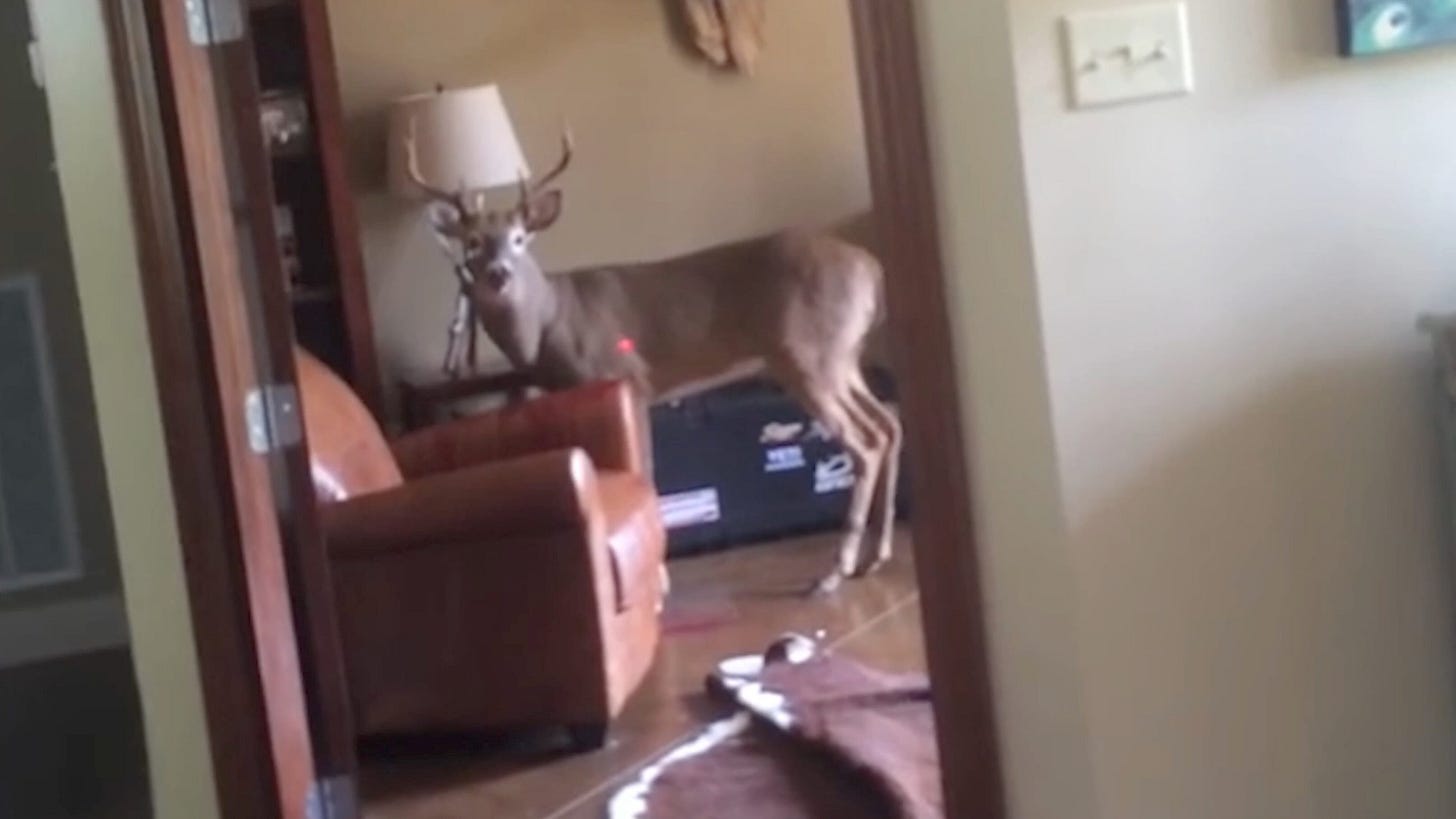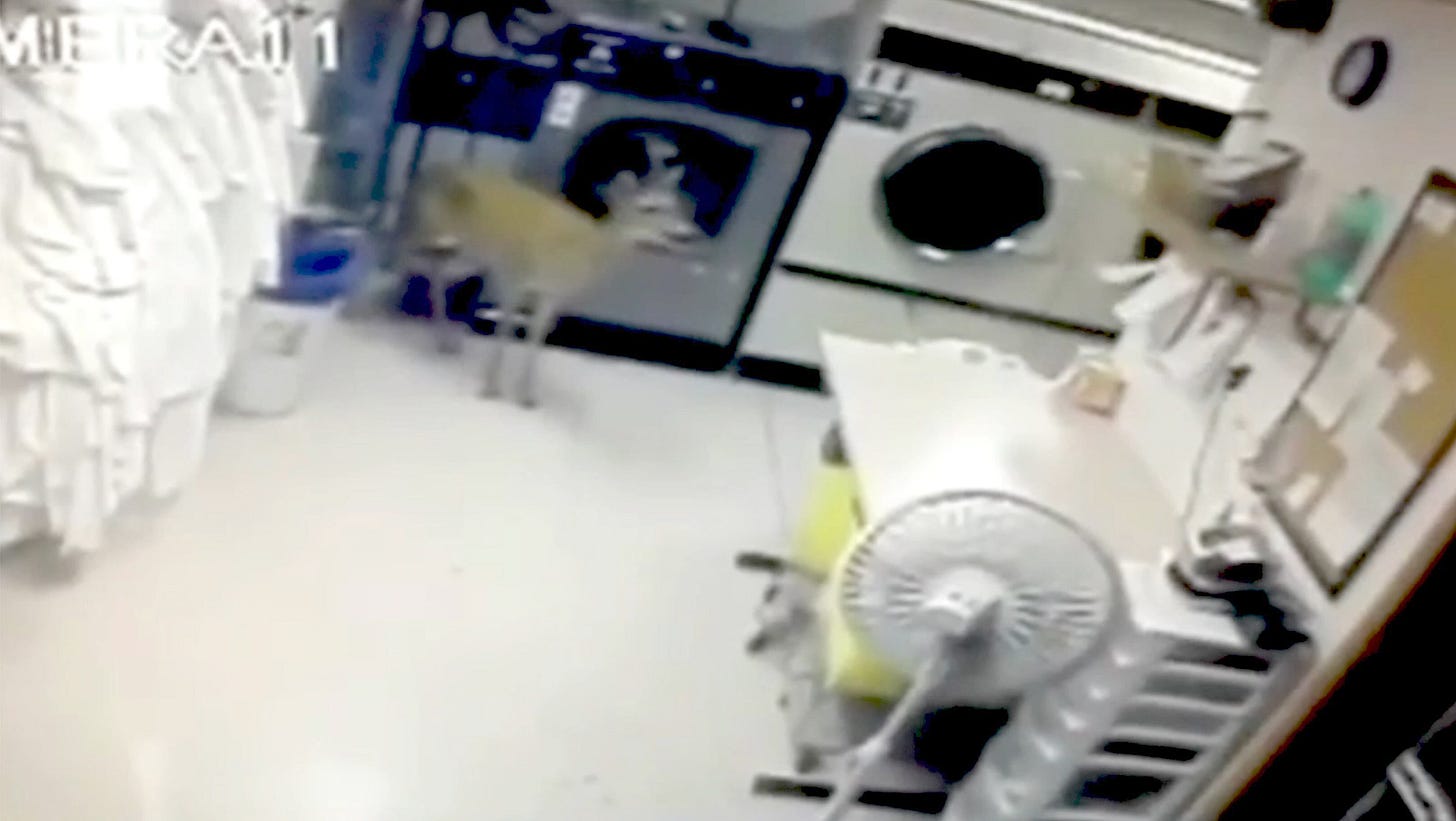Crashing the Gates: A Weak and Panicked Animal
(2024)
A Weak and Panicked Animal, a 12 minute short by Jake Starr, opens with a slow zoom into a photograph. A voiceover describes what we’re looking at as “the edge of a suburban development.” In the far distance is a wooded area. In the foreground are scrubby, untended shrubs, partly covering an old paved walkway, weeds growing up through the cracks. It’s a picture of a typical edge terrain, where tamed, civilized landscape runs into wildness.
The voiceover has an odd tone: the singsongy, naive voice of a young girl. (In fact, it’s a computer-generated voice, although not too obviously.) What makes this tone even odder is its complete disjunction from the writing style, which is a strident polemic on the vile, evil, and terrifying darkness of wild nature. The strange, high-flown and dramatic tone of the writing betrays a deep-seated terror of everything outside of man’s control: “…the trees harbor a disorder of fornication…” This is the same European terror of the woods which we hear in old fairy tales about scared little girls hurrying through the woods to the safety of grandma’s house. Sexuality, hunger, and all of the body’s drives dwell in the forest and are the dangerous enemies of rational thought.
The treatise goes on to praise the safety provided by sidewalks, streets, and the human-built environment. Our suburban enclaves provide a refuge from the unpredictable dangers of the wild. The inviolability of the border between civilization and wilderness is the key to human happiness. The fact that this two and a half minute zoom is of a still image rather than video footage emphasizes the idea of a border, a separation, rather than a specific, real time and place.
Suddenly we are plunged into the chaos of police body-cam footage. The cops are in the process of approaching a house that’s been broken into. We see various other examples of invasions of homes and schools, and frightened children running from a classroom, but we soon learn that the intruders are frightened does and bucks, not thieves. (In some cases, the bucks charge through a glass door or window because they see their own reflection, and they think they’re charging at a rival buck.)
Starr presents us with an incredible collection of this kind of footage, with animals that have gotten themselves trapped inside of office buildings, hotels, restaurants, schools, and homes. The humans dealing with this situation are every bit as freaked out as are the animals. No one seems to know what to do about this terrifying, anomalous crossing of a boundary we assume is impermeable.
We see a series of TV news reports about the incidents, the reporters breathless with the fear and bewilderment caused by the encounters. Frightened animals bash around, knocking over the furniture, as they try to escape from their predicament.
The voiceover continues, the voice now transformed into an obviously computer-generated flatness, while we watch primitive 3D animations of armed police confronting a deer. This digital voice, accompanying digital representations of the encounters, is a full retreat from the physical, bodily experience of the animals, a withdrawal into our idea of the encounter. The writing purports to speak in the deer’s voice, delivering a message to mankind. The deer declaims a strange, oracular prophecy about the ultimate triumph of nature over human designs and pretensions, and the language here is, if anything, even more unhinged in its tone of apocalyptic revenge.
Tellingly, this “voice of the deer” criticizes human civilization in terms of its writing style, complaining that human ideas “only sound like a badly articulated and half finished sentence.” Whoever the speaker is, he hasn’t escaped from his imprisoning paradigm of man’s triumph over nature at all, only turned the fairy tale around, to one where the wolf triumphs over Red Riding Hood. But we’re still wandering around, dazed and confused by our distracting story-telling. In an irony that the text states explicitly, it is we who are the “weak and panicked animals.”
The film ends with a wild collection of the most dramatic examples of the encounters, with animals charging into public spaces, crashing through plate glass at full speed, sending the people scattering. The peaceful sounds of birds and insects, first heard in the opening sequence, are transformed here into nightmarish shrieks, seeming to confirm the computer-voice’s worst fears about wild animals.
We fear the wild because we fear the body. We fear the body because we fear death. A life built on this fear, estranging us from our rightful inheritance as members of the animal kingdom, is a life perpetually out of balance. Starr makes this point in a crystal-clear, highly polemical style. There’s no doubt about the film’s message, but the awkward, strident tone of the narrator’s voice alerts us that the speaker, an artificial voice emanating from the conceptual box in which we’ve tried to contain wildness, is speaking from the heart of the fear, the withdrawal.
The sheer physical impact of watching this footage, the bewildering encounters between large frightened deer and large frightened people, is unsettling enough that we can’t think about the film’s message with any sense of detachment; we’re immersed in the reality of our shared fears. The fragility and rationality of our built environment is predicated on the idea that no one, animal or human, is supposed to freak out and start crashing into things on the street or in a living room. The directness of Starr’s cinematic language might lack subtlety, but it derives a tremendous power by implicating us, cornering us, so that we don’t know where to turn.
My articles on experimental film are freely available to all, but are supported by monthly and annual donations from readers. Please consider becoming a paid subscriber to support my work. Thank you.




